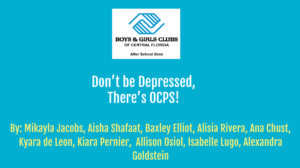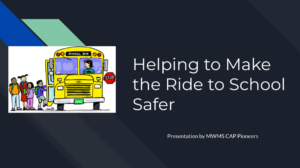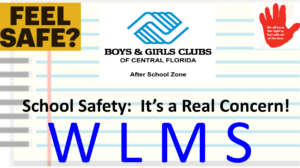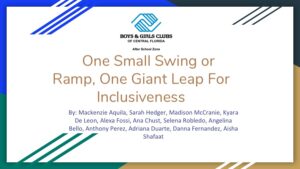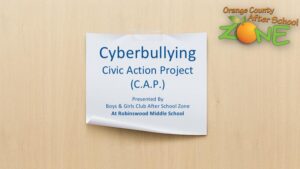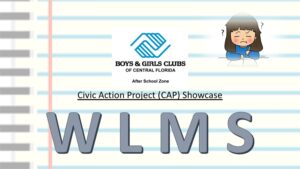Civic Action Project (CAP) is a free project-based learning program for civics and government from the Constitutional Rights Foundation. CAP is a culmination of students’ social studies education, a chance for them to apply what they have learned to the real world and impact an issue that matters to them.
Sign Up to access the FREE curriculum from the Constitutional Rights Foundation.
CAP Projects
Spring 2019
Spring 2018
Spring 2017
Citrus Ridge: A Civics Academy, Polk County, FL – Middle School Public Service Announcement Projects
Students in Action
Programs At-A-Glance
Middle School Semester Curriculum
Lesson 1: What is an Effective Citizen?
Students are introduced to the Civic Action Project (CAP) and the assignment of addressing a problem or issue through informed civic actions.
Lesson 2: Drawing Your Community
Students work in groups to make a drawing of their community with an emphasis on existing needs and resources.
Lesson 3: The River
Students learn about natural and human impact on an environment by examining changes in a hypothetical river system over time.
Lesson 4: What is the Civic Action Project Website?
Students work in groups to explore the various features of the CAP website.
Lesson 5: Exploring Issues and Problems
Students learn the concept of cause and effect and apply their understanding to personal and community examples.
Lesson 6: Policy Introduction
Students look at the link between policy and problems.
Lesson 7: Selecting an Issue
Students begin thinking about selecting their civic action issue.
Lesson 8: Project Proposal Planner
Students are introduced to the Project Proposal Planner and challenged to convince their teacher that the problem, issue, or policy they want to try and impact is important.
Lesson 9: Policy Implications
Students learn further background about the connections between problems, policy, and civic actions.
Lesson 10: Analyzing Homelessness Policies
Students get an additional opportunity to practice analyzing policy by using policies that address homelessness.
Lesson 11: Thinking It Through
Students continue to narrow the focus of their CAP projects by drafting three important questions about their problem or issue.
Lesson 12: Persuading
Students read about and discuss the three types of persuasion: appeal to reason (logos), appeal to emotion (pathos), and appeal to ethics (ethos). Students then prepare two-minute persuasive talks on why their CAP issue is important.
Lesson 13 & 14: Team Presentations
Students present their Civic Action Project issue to their peers.
Lesson 15: The Mayor’s Speech Page
Students learn about the importance of thinking about cost and benefits as they seek solutions to problems
Lesson 16: Civic Action #1: Ask and Answer
Students will begin formulating important questions regarding their Civic Action Project and determine who might be able to provide answers to their questions.
Lesson 17: Civic Action #2: Civic Action Survey
Students discuss and examine the importance of surveys to measure public opinion about their CAP problem or issue.
Lesson 18: Civic Action #3: Support & Oppose
Students conduct interviews with individuals or groups that support and oppose their civic issue.
Lesson 19: Civic Action #4: Raising Awareness — PSA
Students raise awareness about their CAP issues by creating public service announcements.
Lesson 20: Civic Action #5: Students Determine the Action
Students work with their partners to reflect on the civic actions they have already taken, and discuss and devise a plan for their fifth action.
Lesson 21: CAP Report
Students reflect upon, evaluate, and document the learning outcomes of the civic experiences they created through their CAP projects.
Middle School Two-Week Curriculum
Lesson 1: What is an Effective Citizen?
Students are introduced to the Civic Action Project (CAP) and the assignment of addressing a problem or issue through informed civic actions.
Lesson 2: Drawing Your Community
Students work in groups to make a drawing of their community with an emphasis on existing needs and resources.
Lesson 3: Exploring Issues and Problems
Students learn the concept of cause and effect and apply their understanding to personal and community examples.
Lesson 4: Policy Introduction
Students look at the link between policy and problems.
Lesson 5: Project Proposal Planner
Students are introduced to the Project Proposal Planner and challenged to convince their teacher that the problem, issue, or policy they want to try and impact is important.
Lesson 6: Policy Implications
Students learn further background about the connections between problems, policy, and civic actions.
Lesson 7: Persuading
Students read about and discuss the three types of persuasion: appeal to reason (logos), appeal to emotion (pathos), and appeal to ethics (ethos). Students then prepare two-minute persuasive talks on why their CAP issue is important.
Lesson 8: Civic Action #1: Ask and Answer
Students will begin formulating important questions regarding their Civic Action Project and determine who might be able to provide answers to their questions.
Lesson 9: Civic Action #3: Support & Oppose
Students conduct interviews with individuals or groups that support and oppose their civic issue.
Lesson 10: Civic Action #4: Raising Awareness — PSA
Students raise awareness about their CAP issues by creating public service announcements.
Lesson 11: CAP Report
Students reflect upon, evaluate, and document the learning outcomes of the civic experiences they created through their CAP projects.
High School Curriculum
Lesson 1: A Different Kind of Government Course
Students are introduced to the Civic Action Project (CAP) and the assignment of addressing a problem or issue through informed civic actions.
Lesson 2: Introduction to Public Policy
Students look at the link between policy and problems.
Lesson 3: Problems, Policy, and Civic Actions
Students analyze problems in terms of causes and effects and explore how policy can be linked to problems.
Lesson 4: Introducing Policy Analysis
Students look at case studies and are introduced to policy analysis.
Lesson 5: Policymaking in the Three Branches of Government
Students discuss how policy can be made by the executive, legislative and judicial branches of government.
Lesson 6: Analyzing Anti-Gang Policies
Students analyze policy through examples of anti-gang policies.
Lesson 7: Policymaking at the Local Level
Students examine an instance of policymaking at a school board, one of the most common institutions at the local level.
Lesson 8: Law & Policy
Students read about and discuss how law can affect public policy; then they examine hypothetical situations involving CAP students.
Lesson 9: Persuading
Students read about and discuss the three types of persuasion: logos, ethos, and pathos. Students then prepare two-minute persuasive talks on why the issue that they have chosen to address in CAP is important.
Lesson 10: Building Constituencies
Students learn the importance of building a constituency to support or oppose public policies using the case study of the Montgomery Bus Boycott as an example.
Lesson 11: The Public Agenda
Students read about and discuss the public agenda and ways that citizens can influence it.
Lesson 12: Using the Media
Students learn about the importance of the media in setting the public agenda.
Lesson 13: Persuading Policymakers
Students learn about public hearings and how students can make effective presentations at these hearings.
Lesson 14: Creating Change Through the Electoral Process
Students discuss the role that electoral politics plays in policymaking and read and discuss research on youth voting. Students then role play campaign workers and create strategies to attract young people to participate in an election campaign.
Lesson 15: Civic Action Survey
Students discuss and examine the importance of surveys to measure public opinion about their CAP problem or issue.
Questions? Contact Chris Spinale.

